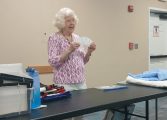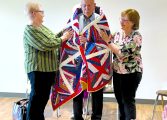By Page H. Gifford
Correspondent
Artist and teacher Leah Olivier spoke to members of the Fluvanna Art Association on March 19 about drawing better by seeing better.
“What you are seeing is not what you think you see,” she said. “Do not filter through your mind what you are seeing.”
Betty Edwards’ “Drawing on the Right Side of the Brain” technique revolutionized drawing and helped amateur artists to draw better by doing the simple act of seeing, not thinking about an object or subject. A proponent of this technique, Olivier is aware of the roadblocks artists endure in learning to draw and who often give up too early. She explained that the problem novice sketchers have is looking at an object and thinking about it but failing to see its shapes. The technique of seeing shapes and translating them to paper, connecting them and building an image then refining it and adding details, develops strong observation skills. Along with Olivier’s 15-minute daily practice, drawing can improve. Any artist or musician will say that it’s not talent alone but practice, practice, practice.
“I make bad drawings and laugh and keep going.” She says she cringes when someone says her work looks like a photograph. She’s not alone, most artists do not consider that a compliment since photographs are flat and 2D. Artists do not strive for photo-realism.
“You will not be able to create depth in your drawings if you copy photos, particularly bad photos,” she said. “To breathe life into your drawings and get depth, draw from life.” She added that if your reference photos are garbage, it’s garbage in and garbage out, and your drawing will look like garbage; repeating, draw from life, or take better photos.
She used ovals as an example of seeing rounded objects, like a cup, which has rounded edges. Looking at from the side as a series of graduated ovals, and two lines connect it as a whole, the cup appears as it should, more rounded rather than straight lines. Adding shadows and shading creates realism.
“Learning to look at shapes helps to internalize and not to think about it. Lines come later when connecting the shapes.” The members then tried a series of times exercises that can be done in a daily 15-minute practice. “Never start with details like an eyeball, it throws the rest of the drawing out of proportion and off the page.”
Members divided their sheet of paper into 4 sections and the first 15 seconds was getting the shapes, then 30 seconds, then another 15 seconds, and then one minute to refine it and add details. Meanwhile, she mentioned one and two-point perspective, measuring angles with a pencil, and humans usually measure eight heads tall.
“When drawing human faces, put marks where the features are and make the shapes, do not look at as a face.”
“The rule to approaching drawing is if it scares you, do it, if it’s bad, learn from it.” Another rule she discussed that is often neglected is anchoring objects. “No UFOs, no flying objects. Nail them down, don’t let it float, give it a table, shadows, and depth.”
After the program, artist Nance Stamper commented to Olivier, “This is the best drawing lesson I ever had.”




